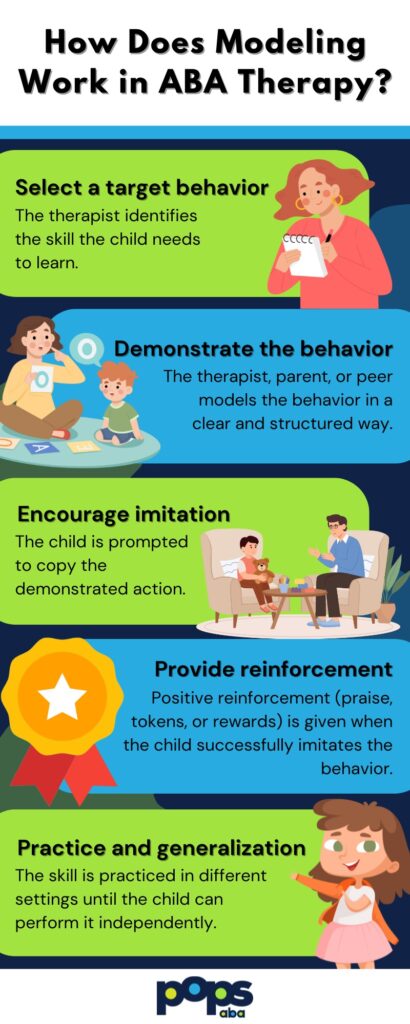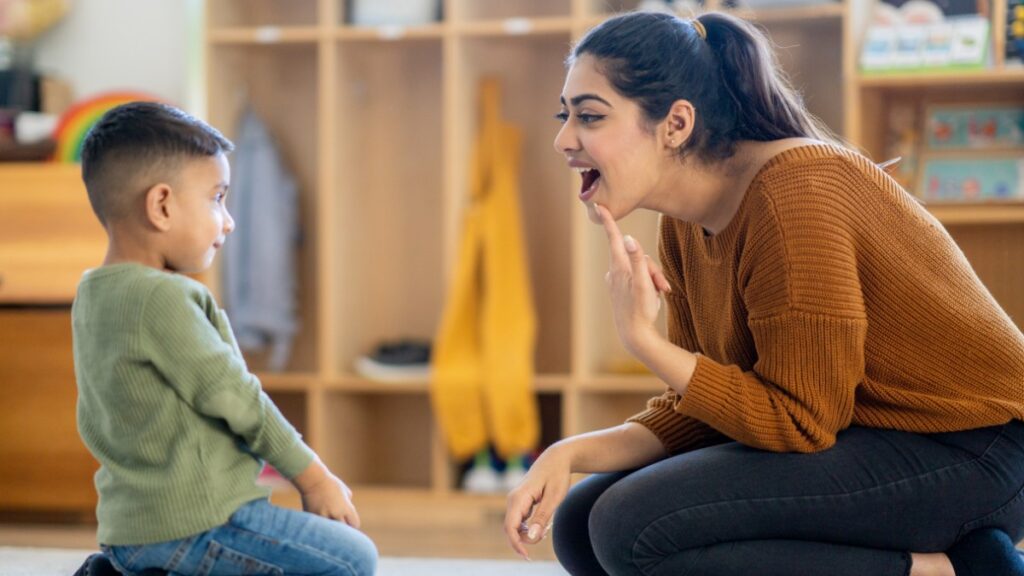Key Points:
- Modeling in ABA therapy is an effective technique where therapists demonstrate desired behaviors to help children with autism and other developmental disorders learn new skills.
- This technique includes live modeling, video modeling, and peer modeling, each tailored to the child’s needs.
- Parents and caregivers play a crucial role in reinforcing modeled behaviors at home to support long-term learning.
Kids naturally learn by watching others, but for children with autism, this process sometimes needs extra support. Modeling in ABA therapy bridges that gap, using real-life examples to teach social, communication, and daily skills. But what makes this approach so effective, and how can it help your child?
What Is Modeling in ABA Therapy?
Modeling in ABA therapy is a teaching technique where a therapist, parent, or peer demonstrates a desired behavior for the child to imitate. This strategy helps individuals with autism learn new skills by watching and copying others.
Modeling can be used for a variety of skills, including:
- Social interactions (e.g., making eye contact, sharing toys)
- Communication (e.g., using words instead of gestures)
- Self-care routines (e.g., brushing teeth, tying shoes)
- Emotional regulation (e.g., expressing frustration appropriately)
Because many children with autism learn best through visual cues, modeling is a natural and effective way to support their development.
How Does Modeling Work in ABA Therapy?
Modeling in ABA follows a structured approach to help children observe, process, and imitate the target behavior. The process typically includes these steps:

This structured approach helps children understand and retain the new skill, increasing the likelihood of long-term success.
Types of Modeling Used in ABA Therapy
Modeling comes in various forms, each suited to different learning styles and needs. Here are the most common types:
1. Live Modeling
In live modeling, a therapist, teacher, or peer demonstrates the behavior in person while the child observes. This method is effective for teaching social skills and daily routines. For example, if a child is learning to greet others, the therapist may model saying, “Hi!” while waving. The child is then encouraged to imitate the greeting in a natural interaction.
2. Video Modeling
Video modeling involves showing the child a pre-recorded video of someone performing the desired behavior. This approach is useful for children who respond well to screen-based learning.
There are different types of video modeling:
- Basic video modeling – The child watches someone else perform the behavior.
- Self-modeling – The child watches themselves successfully performing the skill, often recorded in a previous session.
- Point-of-view modeling – The behavior is recorded from the child’s perspective to enhance understanding.
Studies show that video modeling can be particularly effective for teaching communication and daily living skills.
3. Peer Modeling
In peer modeling, another child demonstrates the behavior. This is especially helpful for social skill development, as children are often more motivated to imitate their peers than adults. For instance, if a child struggles with turn-taking, a peer might model waiting their turn during a game, encouraging the child to follow suit.
4. Symbolic Modeling
Symbolic modeling uses books, cartoons, or role-play scenarios to demonstrate behaviors. This technique is helpful for abstract skills like emotional regulation or problem-solving. For example, reading a story about a character handling frustration in a positive way can help a child understand and replicate similar behaviors.

Benefits of Modeling in ABA Therapy
Modeling provides multiple benefits for children with autism and other developmental challenges. Here’s why it’s such a valuable technique:
1. Encourages Faster Learning
Since many children with autism are visual learners, seeing a behavior in action makes it easier to understand and replicate. Research suggests that observational learning speeds up skill acquisition compared to traditional instruction alone.
2. Improves Social and Communication Skills
Modeling is particularly effective for teaching social behaviors like greeting others, maintaining eye contact, and engaging in conversations. It also helps with nonverbal communication, such as gestures and facial expressions.
3. Promotes Independence
By teaching essential daily living skills, modeling supports a child’s ability to function independently. Tasks like dressing, brushing teeth, and using utensils can be learned more effectively through observation.
4. Reduces Challenging Behaviors
Children who struggle with frustration or emotional regulation can benefit from watching appropriate coping strategies being modeled. For example, demonstrating deep breathing or using words instead of aggression can help reduce problem behaviors.
5. Supports Generalization of Skills
One challenge in ABA therapy is ensuring that a child can apply learned skills in different environments. Modeling helps with this by showing behaviors in various contexts, reinforcing the skill across different settings.
How Parents Can Use Modeling at Home
Parents play a crucial role in reinforcing modeled behaviors outside of therapy sessions. Here are some ways to use modeling at home:
- Demonstrate daily routines – Show your child how to complete tasks step-by-step (e.g., washing hands, putting on shoes).
- Use social modeling – Model appropriate greetings, eye contact, and conversation skills.
- Practice emotional regulation – Show how to handle frustration calmly (e.g., “I feel upset, so I’m taking deep breaths”).
- Reinforce positive behaviors – Praise and reward your child when they successfully imitate modeled behaviors.
By incorporating modeling into everyday interactions, parents can significantly enhance their child’s progress.
ABA Therapy Can Help Your Child Thrive
At Pops ABA, we specialize in evidence-based ABA therapy to help children with autism develop essential life skills. Our team of experienced therapists uses modeling in ABA therapy to teach social skills, communication, and self-care in a supportive environment.
Located in New Jersey and North Carolina, Pops ABA provides personalized ABA therapy designed to support children and their families both at home and in the community. If you’re seeking effective ABA therapy in New Jersey or North Carolina that promotes meaningful, long-term growth, contact us today to learn more about our services.
Let’s help your child reach their full potential—one step at a time.



